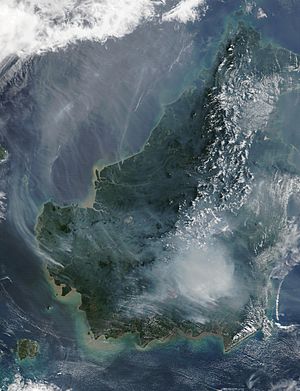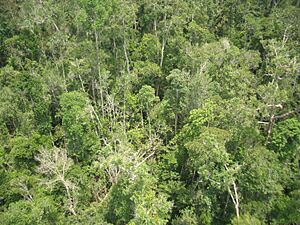Peat swamp forest facts for kids
Peat swamp forests are special forests found in wet areas. They grow in tropical and subtropical parts of the world. These forests have very poor drainage, meaning water doesn't flow away easily.
Because the soil is always full of water, dead leaves and wood don't break down completely. Over a long time, this creates a thick, spongy layer called peat. This peat is very acidic. The forests are mostly made up of broadleaved trees and many different kinds of flowering plants.
Peat swamp forests are often found next to lowland rain forests. These rain forests usually have soil that drains better. Near the coast, you might also find brackish (slightly salty) or salt-water mangrove forests.
These tropical swamp forests are different from peat bogs found in cooler places like Ireland. Those bogs are mostly made of mosses like Sphagnum, grasses, and shrubs, not large trees.
Contents
Where Peat Swamps Are Found
Most of the world's tropical peatlands are in southeast Asia. About 80% of these are in Indonesia. You can also find them in Malaysia, Papua New Guinea, Brunei, Vietnam, the Philippines, and Thailand.
The trees in these forests can grow very tall, up to 70 meters (about 230 feet). The peat itself can be as deep as 20 meters (about 65 feet). This peat is spongy and unstable. It also has very low pH (meaning it's very acidic) and not many nutrients.
The forest floor often gets flooded during the wet season. The water looks dark brown because of chemicals called tannins. These tannins come from fallen leaves and the peat itself. That's why these areas are sometimes called 'blackwater swamps'. Even in the dry season, the peat stays waterlogged, and small pools of water remain among the trees.
Why Peat Swamps Are Important
Tropical peatlands and their swamp forests store huge amounts of carbon. This carbon is stored in the soil as organic matter. They hold much more carbon than many other types of forests. This makes them one of the largest natural stores of carbon close to the Earth's surface.
Even though they are so important, peat swamp forests are in danger. They are also not studied as much as other ecosystems. This means we don't fully understand them yet.
Threats to Peat Swamps
Sadly, large parts of these forests are being logged very quickly. Since the 1970s, many peat swamp forests have been cut down and drained. This is called deforestation.
Natural events like El Niño also cause droughts. These droughts, along with large fires, are destroying peatlands even faster. When these forests are destroyed, they release a lot of carbon into the air as carbon dioxide. This adds to climate change. Tropical peatlands have already become a major source of carbon dioxide.
Tropical peat swamp forests are home to thousands of different animals and plants. Many of these species are rare or critically endangered. For example, the orangutan and Sumatran tiger live here. Their homes are being destroyed by the cutting down of peatlands.
Images for kids
-
A peat swamp forest in Borneo.







